|
Date: June 15, 2001
Contact
Marc Faille, National Manager, Grains and Field Crops Section
Review
This manual is to be reviewed every 2 years. Next review date is June 15, 2003.
Endorsement
Approved by:
| _______________________________________________ Mike Wood, Quality System Document Committee, PHD |
_______________ Date |
|
| _______________________________________________ Director, Plant Health Division |
_______________ Date |
Amendment Record
Amendments to this document will be given consecutive numbers. Amendments will be posted on the CFIA Intranet. With hard copy documents, insert all amendments, remove obsolete pages and ensure the record below is completed.
| Number of amendment: | Amended by: | Date of submission for approval of amendment: | Summary of amendment and number of amended section(s) or page(s): |
Distribution
The most up to date version of this document will be maintained on the CFIA Merlin. In addition, the signed original will be maintained in the Director’s office and the master electronic copy will be kept in the following directory: O:\APHD\PPD\Documents\Reference\R-004.wpd.
Cereals are one of the most important crops grown in Canada, in terms of area cropped, value of production, volume and value of exports. As such, it is very important that they be protected from any pest that could seriously affect production. One of the pests of major concern to cereal growers is black stem rust, (Puccinia graminis Pers.), a fungus which affects cereals such as wheat, oats, barley and rye. In addition to cereals, the fungus has an alternate host, barberry (Berberis spp.), an introduced shrub in Canada. The fungus completes the sexual reproductive phase of its life cycle, which can result in the development of new races of the fungus on the barberry plant. These new races can compromise on-going breeding programs that are aimed at controlling stem rust in cereals. In addition, when barberry is grown in close proximity to cereals it can serve as an early source of inoculum which can lead to significant yield losses. However, the type of spores the fungus produces when infecting barberry are fragile and usually do not result in any long-range spread of the disease.
Control of stem rust disease is achieved through disease resistant breeding programs, the growing of resistant cereal varieties, in addition to the use of cultural controls such as the removal of susceptible barberry species from the vicinity of cereal fields. In an effort to help minimize losses from stem rust disease and to support the on-going programs of cereal breeding for rust resistance, the removal of wild barberry and preventing the introduction and spread of susceptible barberry in Canada has been supported at all government levels.
The common barberry, Berberis vulgaris L., is the most common alternate host for black stem rust fungus. This species is a deciduous shrub that is native to Central Asia. It was introduced into Europe by Arabs around the seventh century, and during the next ten centuries, it spread across Europe before finally being introduced in eastern North America by settlers. It was originally grown as an ornamental and hedge row plant, as well as being cultivated for its berries that were used to produce jellies and wine. The shrub eventually spread westward from its eastern North American introduction area. Through seed dispersal, barberry plants became largely distributed in woods, along creeks and rivers, along fence rows, in orchards, and in almost any location where any tree or shrub can grow.
The relationship of the barberry to the rapid spread of wheat rust was recognized as early as the late 1700's. Following a damaging black stem rust outbreak in 1916, eradication programs for the common barberry were initiated in both the United States (U.S.) and Canada. Surveys and eradication efforts were carried out on the Prairies mainly in the early part of this century (i.e., 1910-1930) and in Ontario and Québec in the 1960's and 1970's.
These eradication programs did not completely eliminate all black stem rust-susceptible barberry plants but did result in the destruction of millions of barberry bushes across North America leading to significant reductions in both the incidence and variability of the stem rust pathogen.
In addition, the provinces of Ontario, Quebec, Manitoba, Saskatchewan and Alberta have designated the common barberry (Berberis vulgaris) a noxious weed. This designation gives these provinces the authority to order the eradication of susceptible barberry when found. However, despite the eradication programs and noxious weed designation, wild barberry and hybrids between wild barberry and other barberry species continue to grow and spread in parts of Canada and the northern U.S. In addition, barberry plants produce abundant seed that are scattered by birds. Even after removal of the parent plants, these seeds can remain dormant in soil for periods of more than 10 years and eventually produce more plants. As a result, without constant surveys and eradication efforts every few years, even in areas where all plants appeared to have been removed, some barberry may continue to grow.
Common Barberry (Berberis vulgaris L.)
In Canada, common barberry has been reported from southern British Columbia, southern Manitoba, Saskatchewan, Ontario, Quebec, New Brunswick, Prince Edward Island, Nova Scotia and Newfoundland. It is known that eradication efforts were not carried out in all areas (e.g., BC, Maritimes), and in areas where they did occur they were usually not 100% successful in removing all bushes or seedlings. As a result, wild barberry is still present in most if not all provinces of Canada, to varying degrees. The plant is very well established in Ontario and eastern parts of Canada. It is reported that since 1980, populations have increased considerably in eastern Ontario and western Quebec because very little effort has been done to control common barberry.
Japanese Barberry (Berberis thunbergii DC.)
The USDA, due to demands from the nursery trade, has been testing horticulturally desirable barberry species including varieties and cultivars of Japanese barberry (Berberis thunbergii DC.) for susceptibility to the stem rust fungus. In the U.S., cultivars of Japanese barberry that test resistant to black stem rust have been permitted, under certain restrictions, to be sold commercially to the public. This has not been the case in Canada, where these varieties have been prohibited from being imported and sold.
Prior to 1966, Japanese barberry was considered by AAFC to be resistant to stem rust, and was on the approved list for importation and sale within Canada. In 1966, based on scientific literature, AAFC concluded that some of the resistant species of barberry were potentially susceptible to certain rust races in some parts of the world and could, therefore, constitute obstacles to the control of stem rust. Berberis thunbergii DC was, then, removed from the approved list.
The Japanese barberry, Berberis thunbergii DC., is a deciduous, multi branched, dense, compact, often thorny shrub that grows to about 1.5 metres in height. The stem surface may be smooth or grooved, with greenish grey, purple or brown bark. This species of barberry is generally considered resistant to stem rust.
In the US, there are approximately 200 susceptible species and/or varieties of Berberis and approximately 64 that are considered resistant to black stem rust of wheat. Berberis thunbergii DC has the largest number of varieties (about 50) that are resistant to the disease.
Certain barberry species can cross-pollinate with other barberry species to form hybrids (e.g. Japanese barberry and common barberry). Some hybrids can be morphologically very similar to either parent and be variable in their susceptibility to the stem rust pathogen. For example, it is possible to have hybrids between Japanese barberry and wild barberry that morphologically resemble the Japanese barberry but yet carry the susceptibility of the wild barberry. To prevent this situation, CFIA has adopted a program equivalent to the one in the US that strives to ensure that only approved stem-rust resistant varieties are imported, sold and multiplied by the nursery trades. This is done by ensuring that the approved varieties are only propagated clonally and are moved and sold under strict requirements.
Over the past few years, CFIA has developed a program under which certain approved rust-resistant varieties of Japanese barberry can be imported and sold in Canada. The program, which allows the importation of USDA-tested stem-rust resistant cultivars of Japanese barberry, was developed in cooperation with the USDA. Under this program, the USDA will be required to monitor the propagation of approved cultivars and issue phytosanitary certificates for plants exported to Canada. In Canada, the plants will retain their identity by strict labelling requirements and application of control measures at nurseries selling and propagating these plants. These requirements are outlined in the Directive, D-01-04, "Plant Protection Import and Domestic Movement Requirements for Barberry and Buckthorn" of the Plant Health Division. Both the identification manual and directive are accessible on the CFIA website.
This identification manual is intended for the use of CFIA staff and industry staff as a guide for the verification of identification of the 11 cultivars of Japanese barberry which are approved for importation and sale in Canada under D-01-04.
Bailey Nurseries, Inc, St. Paul, Minnesota, (1996-1997), Wholesale Catalogue (Special Edition), pp 113-116.
Buckley, A.R. (1980), Agriculture Canada Research Branch-Trees and shrubs of the Dominion Arboretum, Ottawa, publication No. 1697, pp 16-17.
Canada Agriculture, Plant Protection Division (Revised 1997), Plant Protection Import and Domestic Movement Requirements for Barberry, p. 8.
International Union for the Protection of New Plants, (UPOV), (1979), Guidelines for the conduct of tests for Distinctness, Homogeneity, and Stability - Berberis spp., reference TG/68/3, p. 10.
Japanese Barberry (Berberis thunbergii DC.), Objective Description (2000), Plant Breeders’ Rights Office, Canadian Food Inspection Agency Ottawa, 21 p.
Lidsay, D.R. (1951), Canada Department of Agriculture - Division of Botany and Plant Pathology, Ottawa, Survey of Common barberry (Berberis vulgaris L.) in Southwestern Ontario, 20 p.
Marinelli, Janet, (editor), (1998), The Brooklyn Botanic Garden - Gardener’s desk reference, pp 77-83.
Mulligan, Gerald A., (1952), Canada Department of Agriculture - Division of Botany and Plant Pathology, Ottawa, Survey of Common barberry (Berberis vulgaris L.) and European Buckthorn (Rhammus cathartica L.) In Eastern Ontario, 16 p.
Sahota, A.S. (1999) Personal Communication with Nursery Staff (responsible for barberry stock production) regarding the reference material supplied by Bailey Nurseries Inc., St. Paul Minnesota; Monrovia Nursery Company, Azusa, California; and Spring Meadow Nursery, Grand Haven, Michigan.
Stakman, E.C. (1923), U.S.D.A. Department circular 269, 15 p.
The Royal Horticultural Society, U.K., (1966, 1986, 1995) RHS colours chart.
United States Department of Agriculture - Bureau of Entomology and Plant Quarantine, Minneapolis (1946), Nursery Inspection Manual; barberry eradication, 46 p.
BERBERIS THUNBERGII - A Potential Obstacle to the Control of Puccinia graminis, Plant Health Risk Assessment Unit, AAFC, June 1996.
D-90-05, Importation of Berberis, Mahoberberus or Mahania, PPD, Agriculture Canada, 1990.
3.0 Definitions and Abbreviations
| AAFC | Agriculture and Agri Food Canada |
| APHIS | Animal and Plant Health Inspection Services (U.S.) |
| BCP | Barberry Certification Program |
| CFIA | Canadian Food Inspection Agency |
| Deciduous | Plants whose leaves or flower petals are not persistent and fall off at the end of a defined growing season or during a period of temperature or moisture stress. It typically refers to leaves of broad-leaved trees, but some confiners are also deciduous (e.g., larch). |
| Dormant | An organism in a state of reduced physiological activity. |
| Evergreen | Trees with green leaves or needles that are retained throughout the season with no marked period of leaf shedding. |
| Immune | The state of being exempt from infection by a given pathogen. |
| Nursery | In this directive "nursery" includes importers, exporters, wholesalers, propagators and sellers of Japanese Barberry Plants. |
| Resistant | The ability of a plant to overcome, retard, suppress, or prevent infection or colonization by a pathogen, parasite, or adverse abiotic factor. The ability of insects, fungi, weeds, or other pests to survive normally lethal doses of an insecticide, fungicide, herbicide, or other pesticide. The opposite of susceptibility. |
| U.S. | United States |
| USDA | United States Department of Agriculture |
4.0 Descriptions of Rust Cycle
The fungus has five spore stages in its complete life cycle and includes two hosts. The first two spore stages are the uredial and telial stages, which occur on cereal grains (wheat and barley) and several grasses. The uredial stage is often referred to as the repeating stage since it can continue to produce spores on wheat as long as the wheat plant is alive. The sporidia or basidiospores that are produced as a result of the germination of the teliospores (the overwintering spores found on the wheat as black spores when the wheat is ripe) infect barberry early in the spring. The pycnial and aecial stages occur on barberry (Berberis vulgaris L., Berberis canadensis Mill. and Berberis fendleri Gray). The aeciospores infect wheat and produce urediospores.
Each spring the urediospores infecting wheat move in a leap frog fashion from areas in Mexico and Texas northward through the plains and into Canada. In the fall the process is reversed and a few spores manage to survive the winter in the warmer areas of Texas. Although barberry is important to the fungus in producing new races (biotypes), it is not essential for the survival of the fungus. New races may also arise from other means.
On the alternate host (barberry), infection occurs from germinating teliospores from wheat. The disease appears first on the upper surface of the barberry leaf as an orange pustule; later yellow-orange horn-like projections develop on the lower surface of the leaf. Aeciospores produced here are blown into nearby wheat fields where the uredial stage develops.
Stem rust, as the name implies, infects the stems (Figure 1) but is not confined to the stems. It can infect the leaves, sheath, glumes and awns. The infection first appears on wheat as brownish red elongate pustules (lesions) producing urediospores. As the wheat plant matures the pustules begin to produce black spores (teliospores). The urediospores are easily transported by wind and continue to reinfect wheat. In the U.S., these windblown urediospores can move hundreds of miles, infecting wheat over a large area.
Since the barberry is an alternate host, destruction of the barberry is one of the most widely used control methods. Breeding for resistance is the most effective method of controlling stem rust. Since the fungus can produce new races, no variety can be completely immune to rust for long. This explains why new varieties are continually released by plant breeders each year. The new varieties are released after extensive testing for resistance to the present races of stem rust.
Figure 1
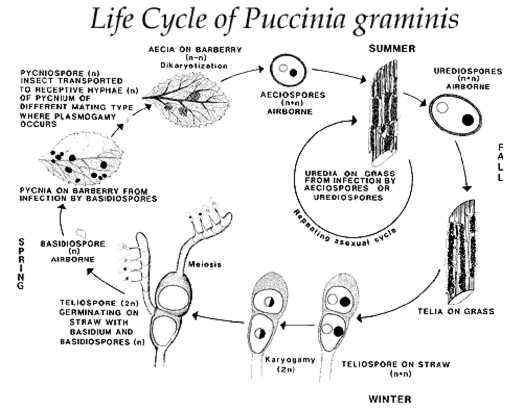 |
The leaf characters are often essential in the identification of a given variety and species. These include the shape as a whole, as well as of the base and tip; outline of the edges; appearance of the upper and lower surfaces; and general texture. A descriptive botanical chart with all those characteristics is included in the manual to ensure clarity of the terminology used. The shape, colour, and size of the berries and the way they are attached to the stalk are also very important in identification. Another pertinent point of difference is the spines of the barberry, which may vary in length, shape and type. Variety names for some varieties may be different than the trade names given to those varieties.
5.1 Common Barberry (Berberis vulgaris L.)
The common barberry is a tall, (approximately 2 metres, occasionally up to 3 metres tall) shrub very susceptible to stem rust. It has characteristic bright yellow roots and inner bark. The stems are woody. Leaves, borne in clusters, are spatulate; (2.5 to 7.0 cm long) generally blunt tipped, base tapers in width into a leaf stalk about one centimetre long. Leaf margins are serrated and spiny. Leaves are dull green, smooth, and some newly emerged leaves may be purplish. Spines usually are tripartite and up to 1.5 cm long, occasionally single or in fives. Branches are straight, strongly grooved, yellowish or sometimes yellowish red when young. Older stems (second year growth) have light grey bark. Flowers are small and yellow in colour. Berries are in clusters. Bright red berries are ellipsoid (up to 10 mm long and 6 mm wide). One to two seeds per berry.
5.2 Japanese Barberry (Berberis thunbergii DC.)*
Japanese barberry is a multi-branched, upright, compact, perennial, often thorny shrub (1-2 m high) with numerous slender branches that may be straight or angled at the nodes. Their stem surface may be smooth or grooved, with greenish grey, purple or brown bark. Inner bark, wood and roots are of bright yellow colour. Branches have alternate, strong, slender sharp spines (single or three-pronged) at the nodes, with short leafy shoots in their axils.
The deciduous leaves are simple, entire, borne in alternate clusters, and depending on the variety, may be of various shapes, sizes and colours. Leaf blades are usually obovate to oblong or spatulate, with obtuse, mucronate, or acute apexes, and are tapered towards the base. Petioles are winged.
Depending upon variety, the flowers are normally produced in May or June. Numerous small flowers are borne solitary or in umbel-like drooping clusters, with small yellow calyx and corolla (8-10 mm), and are insect pollinated.
Fruits or berries (bright red or greenish yellow colour), usually ellipsoid to globular (8-10 mm long) are borne in drooping clusters in September-October.
The approved varieties of Japanese barberry that have tested immune or highly resistant to black stem rust (Puccinia graminis Pers.) of wheat. Those varieties are listed in Appendix 1 of Directive D-01-04 dated June 15, 2001 and are described in the following pages along with their photographs.
The distinguishing morphological characteristics given in each of these description of varieties are adequate for proper identification of Japanese varieties.
*(In genus berberis the species "thunbergii", in honour of Carl Peter Thunberg, 1743-1828, a Swedish botanist author of Icones Plantarium Japonicarum, a first flora of Japan).
5.3 Glossary of botanical terms used in describing berberis varieties
| Leaf Shapes | |
| Ovate | Leaf egg-shaped, slightly broader near the base and narrower toward the tip; like an egg set up on its broad end. |
| Obovate | Leaf egg-shaped, slightly narrower near the base and broader toward the tip; like an egg set up on its narrow end. |
| Elliptic | Leaf oval; broadest near the middle and narrowing toward the base and tip. |
| Lanceolate | Leaf shaped like a spear head; broader and rounded at the base and narrowing to a point at the tip. |
| Oblanceolate | Leaf shaped like a spear head, as in lanceolate, but widest about 3/4 of the way to the tip. |
| Spatulate | Leaf shaped like a frying pan, with a long, narrow base, widening abruptly to a rounded, blunt shape. |
| Leaf Margins | |
| Entire | Margins smooth, without any teeth, spines or lobes |
| Serrate | Margins with teeth. |
| Spiny | Serrate Margins with teeth with spines. |
| Leaf Tips | |
| Acuminate | Leaf tip sharply-pointed with a long tapering tip. |
| Acute | Leaf tip sharply pointed. |
| Obtuse | Leaf tip blunt or rounded. |
| Mucronate | Leaf abruptly tipped with a small, sharp spine. |
| Leaf Veins | |
| Reticulate | Veins forming a network. |
| Spine Types | |
| Single | Only one central spine at each node. There are usually minute lateral spines present that can only be seen with magnification. |
| Tripartite | Three spines at each node. The two lateral spines may vary in size from much shorter than the central spine to somewhat longer. |
| Spine Shapes | |
| Needle-shaped | Spines narrow and needle-like, although stouter at the base. The spines, even though needle-shaped, are often grooved, or the edges may be folded under. |
| Flattened | Spines quite broad and flat at the base, tapering toward a sharp tip. The edges are arrow-shaped folded under. |
| Stem Surface | |
| Terete | Stem cylindrical and round in cross-section |
| Grooved | Bark with shallow to deep, longitudinal grooves. |
| Stem Shape | |
| Straight | Stems nearly straight; not changing direction at each node. |
| Angular | Stems changing direction slightly at each node. |
| Inflorescence or Berry Cluster Types | |
| Fascicled | Simple cluster, with each berry on a separate stem. |
| Umbel-like | Simple cluster, like the above, but with the berry-bearing stems at the end of a short stem. |
| Simple Raceme | Simple cluster, with the berry-bearing stems arranged along a longer stem. |
| Fascicled Raceme | Compound cluster, like the above but with fascicle-like clusters of berries at each node rather than a single berry-bearing stem. |
| Panicle | Compound cluster, like the above but with umbel-like clusters at each node rather than fascicles. |
| Berry Shapes | |
| Ellipsoid | Berries with an elliptical outline. |
| Ovoid | Berries with an ovate outline |
| Subglobose | Berries nearly round. |
5.4 Botanical Characters used in Identifying Berberis Varieties
Figure 2
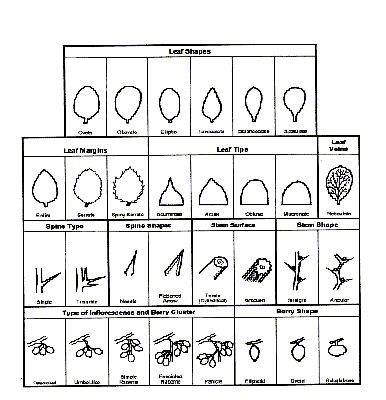 |
5.5 Identification key for barberry varieties
How to Use Key:
By using specific botanical traits listed in the key, varieties may be identified through a process of selection and elimination. Follow through the list of characteristics starting at 1. There are two choices at each step, until identification is completed.
The first character is plant width in a well developed mature plant. If the specimen to be identified is wider than 90 cm then go to 6 (spines).
If the spines are longer than 10 mm, then go to 8 (leaf shape).
If leaf shape of the specimen is elliptic, obovate or oblanceolate, then go to 9 (leaf apex and spine shape).
If the leaf apex is obtuse-mucronate and spines arrow shaped, then this specimen fits the description of barberry variety "Emerald Carousel". At this point, it is recommended that the specimen is compared to the full description of the variety.
| 1 (0). | Plant width up to 50 cm, or greater than 50, up to 90 cm | 2 |
| Plant width greater than 90 cm | 6 | |
| 2 (1). | Spines up to 10 mm | 3 |
| Spines greater than 10 mm | 5 | |
| 3 (2). | Spines single | 4 |
| Spines tripartite | 4 - Aurea Nana | |
| 4 (3). | Flowers yellow; Plant height greater than 30, up to 90 cm, or greater than 90 cm; | |
| Berry width 3 mm | 5 - Jade Carousel | |
| Flowers green; Plant height up to 30 cm; Berry width 2 mm | 3 - Golden Nugget | |
| 5 (2). | Leaf apex obtuse | 9 - Royal Burgundy |
| Leaf apex obtuse-mucronate | 7 - Concorde | |
| 6 (1). | Spines up to 10 mm | 7 |
| Spines greater than 10 mm | 8 | |
| 7 (6). | Leaf apex obtuse; Plant compact; Flowers greenish yellow | 2 - Sunsation |
| Leaf apex obtuse-mucronate; Plant open or rounded; Flowers yellow | 10 - Royal Cloak | |
| 8 (6). | Leaf shape elliptic, or obovate, or oblanceolate | 9 |
| Leaf shape spatulate | 11 | |
| 9 (8). | Leaf apex obtuse; Spines needle-shape | 10 |
| Leaf apex obtuse-mucronate; Spines arrow-shape | 6 - Emerald Carousel | |
| 10 (9). | Internode alignment straight; Leaf margins serrated; Leaves green | 1 - Common Barberry |
| Internode alignment angled; Leaf margins entire; Leaves red | 11 - Ruby Carousel | |
| 11 (8). | Berries greenish yellow, or pinkish red | 12 - Rose Glow |
| Berries bright red | 8 - Cherry Bomb |
DESCRIPTION OF COMMON BARBERRY
| Specimen collected at: Banks of Ottawa River Ottawa, Ontario, Canada in 1999 |
Species Name: Berberis vulgaris
L. Trade Name: Common Barberry |
| Plant growth habit: Erect, tall with upper branches flaring out Plant height: Plant width: Stems and branches: |
 |
| Leaf shape (Lamina): Elliptic to obovate Leaf apex: Leaf margins: Leaf size: Leaf distribution: Leaf colour (upper surface): Leaf colour (lower surface): Leaf texture (upper surface): |
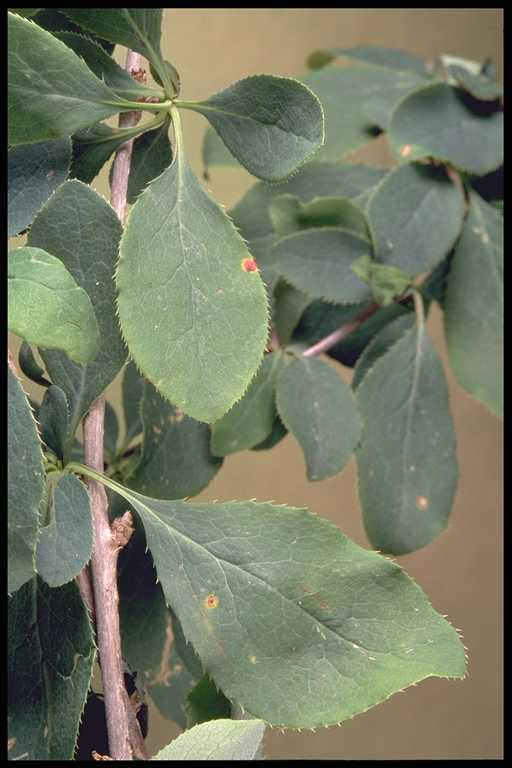 |
| Spines: Arranged alternately, tripartite, occasionally single or in fives. Spine shape: Spine length: |
 |
| Flowers: Yellow
|
 |
| Berry clusters: | In clusters of 6-11 berries |
| Berry shape: | Ellipsoid |
| Berry size: | Up to 6 mm x 3 mm |
| Berry colour: | Bright red |
Reference No.: CB-96-04
Date: September 1999
| Year of Testing: 1995 Breeder: Henry H. Eilers H. E. Nursery |
Species Name: Berberis thunbergii
DC. Variety Name: ‘Monry’ Trade Name: Sunsation® |
| Method of Breeding: Both "Monlers" and "Monry" are siblings that were selected from a group of 50-100 seedlings about 1977. The seedlings were from an uncontrolled cross but believed to be Berberis thunbergii "Aurea" crossed with Berberis thunbergii "Kobold". | |
| Plant growth habit: Compact, dense and dwarf - a slow grower Plant height: Plant width: |
 |
| Stems and branches: Grooved, slightly angled, pale green to brown. Leaf shape (Lamina): Leaf apex: Leaf margins: Leaf size: Leaf colour (upper surface): Leaf colour (lower surface): Leaf texture (upper surface): |
 |
| Spines: Arranged alternately, single to tripartite with two small (1-2 mm) side spines at base; approximately at 45° angle to the stem Spine shape: Spine length:
|
 |
| Flowers: | Greenish yellow |
| Berry clusters: | Solitary or in clusters of 2 to 3 berries |
| Berry shape: | Subglobose |
| Berry size: | 2 mm x 2 m |
| Berry colour: | Greenish yellow |
Reference No.: CB-99-09
Date: September 1999
| Year of Testing: 1996 Breeder: Unknown |
Species Name: Berberis
thunbergii DC. Variety Name: Unknown Trade Name: Aurea Nana |
| Method of Breeding: Unknown | |
| Plant growth habit: Compact Plant height: Plant width:
|
 |
| Stems and branches: Grooved, slightly angled Leaf Shape (Lamina): Leaf Apex: Leaf Margins: Leaf Size: Leaf Distribution: Leaf colour (upper surface): Leaf colour (lower surface): Leaf Texture (upper surface): |
 |
| Spines: Alternate arrangement, usually tripartite with equally long side spines. Some single spines. Approximately at 45° angle to the stem. Spine shape: Spine length:
|
 |
| Flowers: | Yellow, inconspicuous. |
| Berry clusters: | Solitary or in clusters of 2 to 3 berries. |
| Berry shape: | Ellipsoid |
| Berry size: | 4 mm x 2 mm |
| Berry colour: | Greenish yellow |
Reference No.: CB-98-05 and CB-99-05
Date: September 1999
| Year of Testing: 1991 Breeder: Henry H. Eilers H. E. Nursery |
Species Name: Berberis
thunbergii DC. Variety Name: ‘Monlers’ Trade Name: Golden Nugget™ |
| Method of Breeding: Both "Monlers" and "Monry" are siblings that were selected from a group of 50-100 seedlings about 1977. The seedlings were from an uncontrolled cross but believed to be Berberis thunbergii "Aurea" crossed with Berberis thunbergii "Kobold". | |
| Plant growth habit: Dwarf form, very dense, compact Plant height: Plant width: Stems and branches: |
 |
| Leaf shape (Lamina): Oblanceolate - Spatulate Leaf apex: Leaf margins: Leaf size: Leaf distribution:
Leaf colour (lower surface): Leaf texture (upper surface): |
 |
| Spines: Arranged alternately, single; approximately at 45° angle to the stem Spine
shape: Spine length: |
 |
| Flowers: | Green |
| Berry clusters: | Solitary in clusters of 2 to 3 berries |
| Berry shape: | Subglobose |
| Berry size: | 2 mm x 2 mm |
| Berry colour: | Greenish yellow |
Reference No.: CB-99-11
Date: September 1999
| Year of Testing: 1992 Breeder: |
Species Name: Berberis
thunbergii DC. Variety Name: ‘Monomb’ Trade Name: Cherry Bomb® |
| Method of Breeding: "Monomb" is a sport of Berberis Thunbergii "Crimson Pygmy" that was selected at Monrovia Nursery. | |
| Plant growth habit: Compact Plant height: Plant width: Stems and branches: |
 |
| Leaf shape (Lamina): Spatulate Leaf apex: Leaf margins: Leaf size: Leaf distribution: Leaf colour (upper surface): Leaf colour (lower surface): Leaf texture (upper surface): |
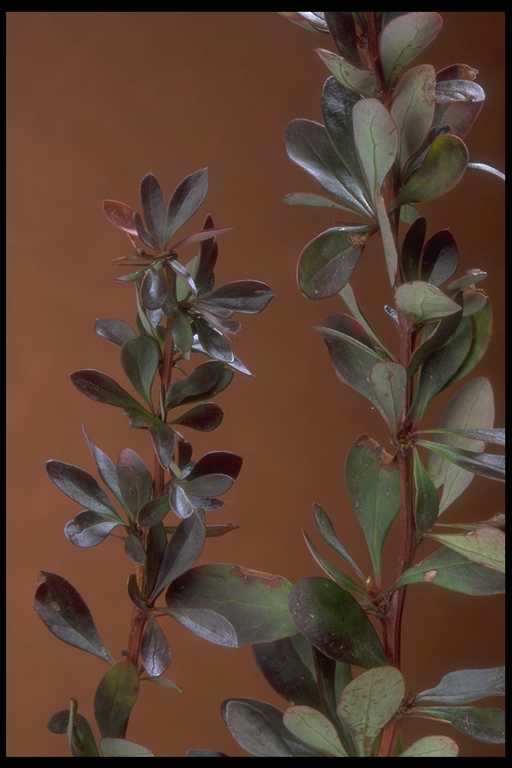 |
| Spines: Single, arranged alternately, almost perpendicular to the stem Spine shape: Spine length: |
 |
| Flowers: | Yellow |
| Berry clusters: | Solitary or in clusters of 2 to 4 berries |
| Berry shape: | Ellipsoid |
| Berry size: | 6 mm long x 3 mm wide |
| Berry colour: | Bright red |
Reference No.: CB-99-10
Date: September 1999
| Year of Testing: 1996 Breeder: Wavecrest Nursery |
Species Name: Berberis
thunbergii DC. Variety Name: Unknown Trade Name: Concorde |
| Method of Breeding: Unknown | |
| Plant growth habit: Dwarf, compact Plant height: Plant width: Stems and branches: |
 |
| Leaf shape (Lamina): Spatulate to obloncealate Leaf apex: Leaf margins: Leaf size: Leaf distribution: Leaf colour (upper surface): Leaf colour (lower surface): Leaf texture (upper surface): |
 |
| Spines: Arranged alternately, mainly single, some with two small side spines at base; at approximately 45° angle to the stem Spine shape: Spine length: |
 |
| Flowers: | Yellow |
| Berry clusters: | Solitary or in clusters of 2 to 3 berries |
| Berry shape: | Ellipsoid |
| Berry size: | 6 mm x 3 mm |
| Berry colour: | Bright red |
Reference No.: CB-98-06
Date: September 1999
| Year of Testing: 1992 Breeder: Terry Schwarts of Bailey Nurseries |
Species Name: Berberis
koreana Palib X (Berberis thunbergii DC.) Variety Name: ‘Tara’ Trade Name: Emerald Carousel |
| Method of Breeding: open pollinated seedling between Berberis koreana and b. thunbergii | |
| Plant growth habit: Rounded with arching branches Plant height: 90 cm to 110 cm tall Plant width: Up to one meter wide Stems and branches: Grooved, slightly angled, green to light brown |
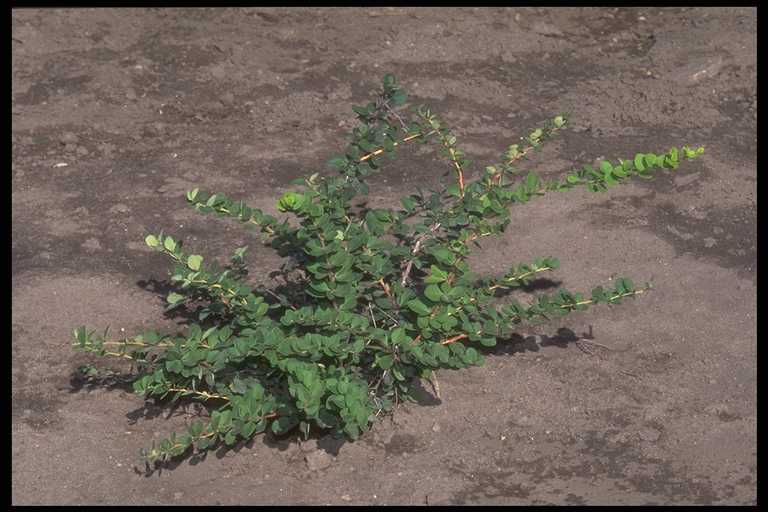 |
| Leaf shape (Lamina): Obovate Leaf apex: Obtuse mucronate Leaf margins: Entire Leaf size: 20 - 26 mm long x 13 - 19 mm wide Leaf distribution: Arranged alternately in clusters of 2 to 4 leaves Leaf colour (upper surface): Dark green leaves with a thin golden yellow line at the margins. New growth leaves pale green. RHS colour chart code 137A and darker. New growth leaves 144A. Fall foliage turns reddish Leaf colour (lower surface): Light green Leaf texture (upper surface): Smooth |
 |
| Spines: Alternate arrangement. Single to
tripartite with dark brown tips, approximately 40° to 70° angle to the stem Spine shape: Flat arrow shaped, 2 to 3 mm wide at the base, thick edges folded backward Spine length: 17 mm long x 3 mm wide at base |
 |
| Flowers: | Yellow |
| Berry clusters: | Solitary or in clusters of 2 to 3 berries |
| Berry shape: | Ellipsoid |
| Berry size: | 6 mm x 3 mm approximately |
| Berry colour: | Bright red |
Reference No.: CB-98-02
Date: September 1999
| Year of Testing: 1996 Breeder: Donald Seliger of Bailey Nurseries |
Species Name: Berberis
thunbergii DC. Variety Name: ‘Bailgreen’ Trade Name: Jade Carousel ® |
| Method of Breeding: Seedling selection from a population of Berberis thundergii seedlings | |
| Plant growth habit: Compact Plant height: 90 cm tall Plant width: 90 cm wide Stems and branches: Grooved, slightly angled, pale green to brown |
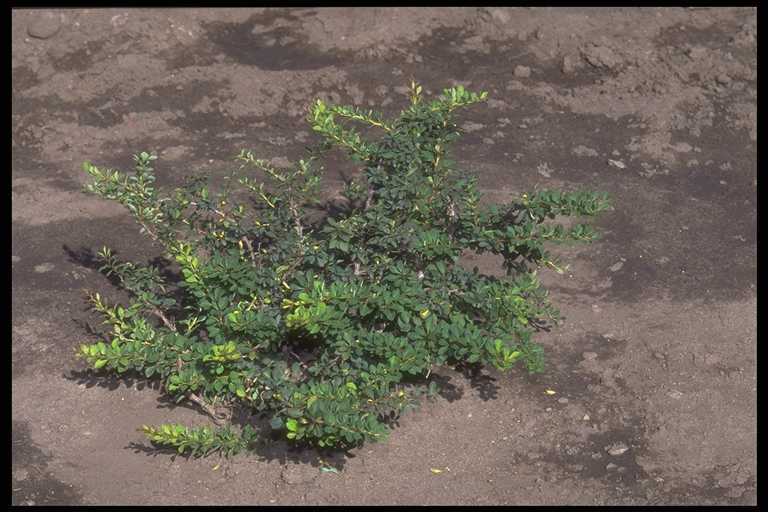 |
| Leaf shape (Lamina): Oblanceolate Leaf apex: Obtuse Leaf margins: Entire Leaf size: 10 -24 mm long x 5 - 9 mm wide Leaf distribution: Arranged alternately in clusters of 2 to 3 leaves Leaf colour (upper surface): Dark green. New growth leaves pale green RHS colour chart code 137B and darker. New growth leaves 144B Leaf colour (lower surface): Light green Leaf texture (upper surface): Smooth |
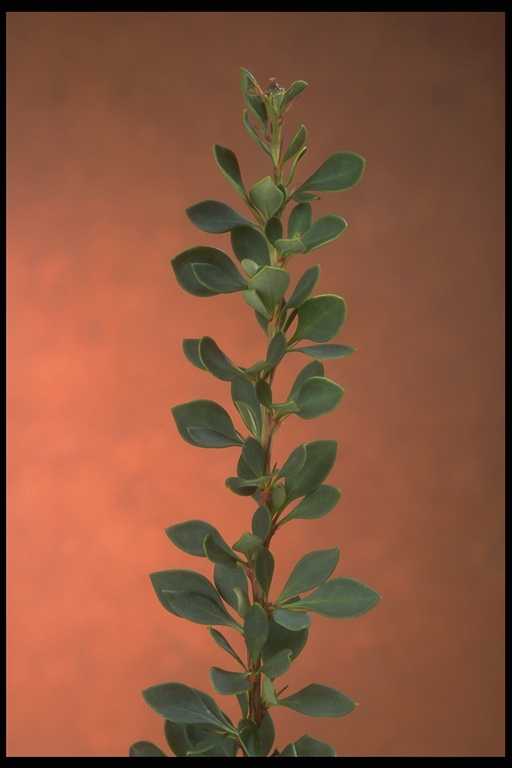 |
| Spines: Alternate arrangement. Usually single
with brown tips, a few with two small side spines at base; approximately 60° to 70°
angle to the stem Spine shape: Needle shape, thicker towards base, edges folded backward Spine length: 10 mm long |
 |
| Flowers: | Yellow |
| Berry clusters: | Solitary or in clusters of 2-3 berries |
| Berry shape: | Ellipsoid |
| Berry size: | 6 mm x 3 mm approximately |
| Berry colour: | Bright red |
Reference No.: CB-98-03
Date: September 1999
| Year of Testing: Breeder: |
Species Name: Berberis
thunbergii DC. Variety Name: Unknown Trade Name: Rose Glow |
| Method of Breeding: | |
| Plant growth habit: Rounded, compact Plant height: Up to 140 cm tall Plant width: Up to 130 cm wide Stems and branches: Grooved, slightly angled, red to brown |
 |
| Leaf shape (Lamina): Spatulate Leaf apex: Obtuse Leaf margins: Entire Leaf size: 20-28 mm long x 9-15 mm wide Leaf distribution: Arranged alternately in clusters of 4 to 7 leaves Leaf colour (upper surface): Red rose, and pink mottled leaves matures to variegated pinkish, purple glowing foliage in autumn. RHS colour chart code 187A, pinkish purple mottling 185C Leaf colour (lower surface): Greenish grey to greyish red Leaf texture (upper surface): Smooth |
 |
| Spines: Alternate arrangement, single,
approximately at a 45° angle to the stem Spine shape: Needle shape Spine length: Up to 12 mm long |
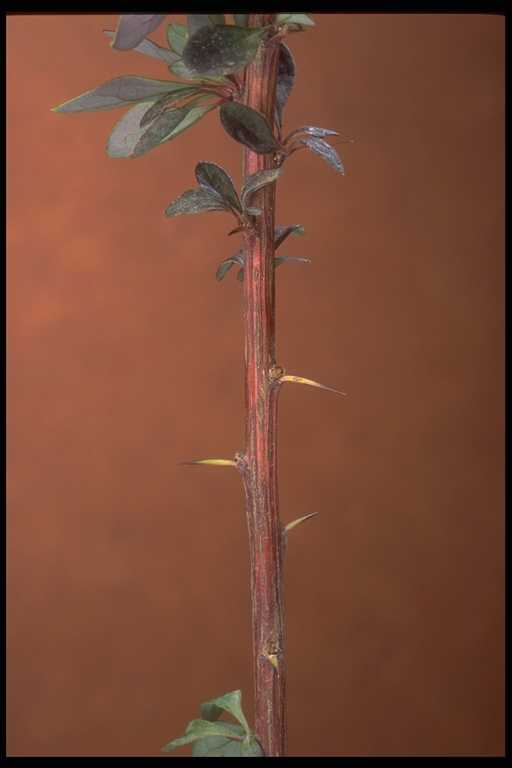 |
| Flowers: | Yellow |
| Berry clusters: | Solitary or in clusters of 2 to 4 berries |
| Berry shape: | Ellipsoid |
| Berry size: | 6 mm x 3 mm approximately |
| Berry colour: | Pink red |
Reference No.: CB-96-01
Date: September 1999
| Year of Testing: 1993 Breeder: Max Lamis of Bailey Nurseries |
Species Name: Berberis thunbergii
DC. Variety Name: ‘Bailone’ Trade Name: Ruby Carousel ® |
| Method of Breeding: seeding selection made from Berberis thunbergii atropurpurea in Oregon. | |
| Plant growth habit: Low, rounded Plant height: 90 cm to 110 cm tall Plant width: Up to one meter wide Stems and branches: Grooved, slightly angled, pale green to reddish brown |
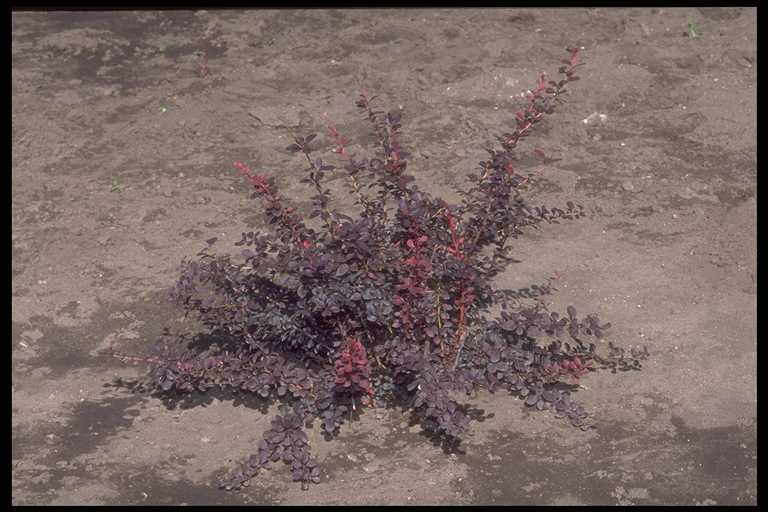 |
| Leaf shape (Lamina): Obovate Leaf apex: Obtuse Leaf margins: Entire Leaf size: 20 - 26 mm long x 9 - 12 mm wide Leaf distribution: Arranged alternately in clusters of 3-6 leaves Leaf colour (upper surface): Deep purplish red. New growth leaves red Leaf colour (lower surface): Light red to greenish red Leaf texture (upper surface): Smooth |
 |
| Spines: Arranged alternately, single;
approximately at 40° to 90° angle to the stem Spine shape: Needle shape, thicker at base Spine length: 12 mm long |
 |
| Flowers: | Yellow |
| Berry clusters: | Solitary or in clusters of 2 to 4 berries |
| Berry shape: | Ellipsoid |
| Berry size: | 6 mm x 3 mm approximately |
| Berry colour: | Bright red |
Reference No.: CB-98-04
Date: September 1999
| Year of Testing: 1996 Breeder: Unknown |
Species Name: Berberis
thunbergii DC. Variety Name: Unknown Trade Name: Royal Cloak |
| Method of Breeding: Unknown | |
| Plant growth habit: Upright arching habit Plant height: 140 cm to 170 cm tall Plant width: 120 cm to 150 cm Stems and branches: Grooved, slightly angled, brown |
 |
| Leaf shape (Lamina): Oblanceolate Leaf apex: Obtuse mucronate Leaf margins: Entire Leaf size: 25 - 30 mm long x 13 - 15 mm wide Leaf distribution: Arranged alternately in clusters of 2 to 9 leaves Leaf colour (upper surface): Velvety dark reddish purple leaves. New growth leaves red. RHS colour chart code 187A. New growth leaves 187D Leaf colour (lower surface): Greenish grey Leaf texture (upper surface): Smooth |
 |
| Spines: Arranged alternately. Usually single
with dark tips. Some tripartite with two small side spines; spines tend to curve downward Spine shape: Needle shape thicker towards base, edges folded back Spine length: Up to 8 mm long |
 |
| Flowers: | Yellow |
| Berry clusters: | Solitary or in clusters of 2 to 4 berries |
| Berry shape: | Ellipsoid |
| Berry size: | 6 mm x 3 mm |
| Berry colour: | Bright red |
Reference No.: CB-98-08
Date: September 1999
| Year of Testing: 1996 Breeder: Leo Gentry Gentry Nursery |
Species Name: Berberis
thunbergii DC. Variety Name: ‘Gentry’ Trade Name: Royal Burgundy® |
| Method of Breeding: Unknown | |
| Plant growth habit: Compact Plant height: 50 cm to 60 cm tall Plant width: 50 cm wide Stems and branches: Grooved, slightly angled, reddish brown
|
 |
| Leaf shape (Lamina): Spatulate Leaf apex: Obtuse Leaf margins: Entire Leaf size: 16 - 25 mm long x 10 - 12 mm wide Leaf distribution: Arranged alternately in clusters of 2 to 7 leaves Leaf colour (upper surface): Velvety burgundy purple foliage turns black red in autumn. New growth purplish red RHS colour chart code 187A, New growth leaves 187D Leaf colour (lower surface): Red to light greenish Leaf texture (upper surface): Smooth |
 |
| Spines: Arranged alternately, usually single,
some with two small side spines at base, almost perpendicular to the stem Spine shape: Needle shape, edges folded back Spine length: Up to 20 mm long |
 |
| Flowers: | Yellow |
| Berry clusters: | Solitary or in clusters of 2 to 4 berries |
| Berry shape: | Ellipsoid |
| Berry size: | 6 mm x 3 mm |
| Berry colour: | Bright red |
Reference No.: CB-98-07
Date: September 1999
Top of Page |
Important Notices |